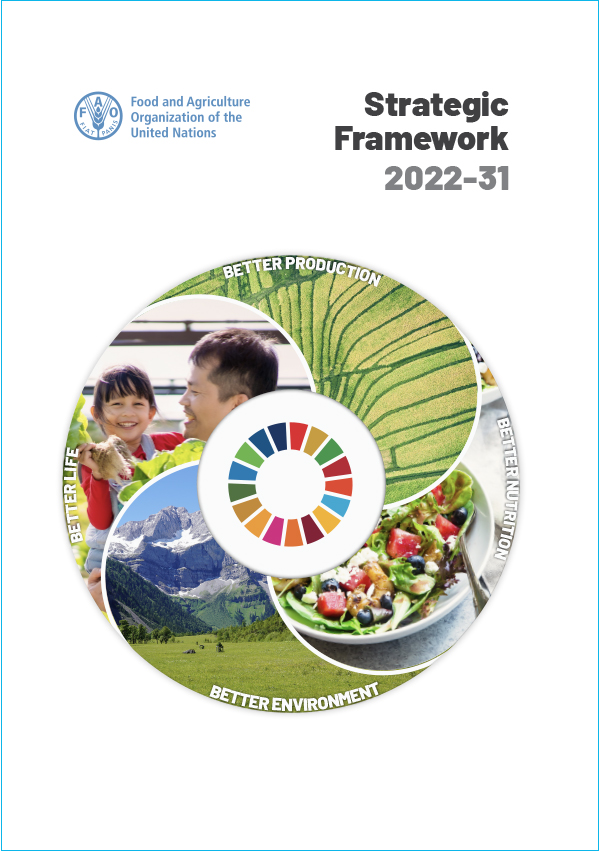
A sustainable and food secure world for all
A world facing escalating threats demands that we act without delay to safeguard life, transform our agrifood systems to future-proof our planet and lock in sustainable outcomes.
FAO Strategic Framework 2022-31 articulates FAO’s vision of a sustainable and food secure world for all, in the context of the Agenda 2030 for Sustainable Development.
What is the FAO Strategic Framework
Since 2010 all of FAO’s work is guided by a Strategic Framework prepared for a period of ten to fifteen years, reviewed every four years.
FAO Strategic Framework 2022-2031 was developed in the context of major global and regional challenges in the areas of FAO's mandate, including the COVID-19 pandemic. It was developed through an inclusive, transparent process involving extensive internal and external consultations, Governing Body meetings and informal consultations. It was endorsed at the 42nd session of the FAO Conference on 18 June 2021.
The four betters and leaving no one behind
FAO Strategic Framework 2022-31 seeks to support the 2030 Agenda through the transformation to MORE efficient, inclusive, resilient and sustainable agrifood systems for better production, better nutrition, a better environment, and a better life, leaving no one behind.

Better production
Ensure sustainable consumption and production patterns, through efficient and inclusive food and agriculture supply chains at local, regional and global level, ensuring resilient and sustainable agrifood systems in a changing climate and environment.
Programme Priority Areas:
Innovation for sustainable agriculture production / Blue transformation / One Health / Small-scale producers’ equitable access to resources / Digital agriculture

Better nutrition
End hunger, achieve food security and improved nutrition in all its forms, including promoting nutritious food and increasing access to healthy diets.
Programme Priority Areas:
Healthy diets for all / Nutrition for the most vulnerable / Safe food for everyone / Reducing food loss and waste / Transparent markets and trade

Better environment
Protect, restore and promote sustainable use of terrestrial and marine ecosystems and combat climate change (reduce, reuse, recycle, residual management) through more efficient, inclusive, resilient and sustainable agrifood systems.
Programme Priority Areas:
Climate change mitigating and adapted agrifood systems / Bioeconomy for sustainable food and agriculture / Biodiversity and ecosystem services for food and agriculture / Achieving sustainable urban food systems

Better life
Promote inclusive economic growth by reducing inequalities (urban/rural areas, rich/poor countries, men/women).
Programme Priority Areas:
Gender equality and rural women’s empowerment / Inclusive rural transformation / Agriculture and food emergencies / Resilient agrifood systems / Hand-in-Hand
(HIH) Initiative / Scaling up investment
The four betters represent an organising principle for how FAO intends to contribute directly to SDG 1 (No poverty), SDG 2 (Zero hunger), and SDG 10 (Reduced inequalities) as well as to supporting achievement of the broader SDG agenda, which is crucial for attaining FAO’s overall vision.
The four betters reflect the interconnected economic, social and environmental dimensions of agrifood systems. They also encourage a strategic and systems-oriented approach within all FAO’s interventions.
FAO will apply four cross-cutting/cross-sectional “accelerators”: (i) technology, (ii) innovation, (iii) data, and (iv) complements (governance, human capital, and institutions) in all its programmatic interventions to accelerate impact while minimizing trade-offs. FAO will also take into account the three cross-cutting themes of gender, youth and inclusion in order to ensure the achievement of the UN programming principle of leaving no one behind.
A reinvigorated business model fit for purpose
FAO Strategic Framework 2022-31 also highlights the importance of a shift in FAO’s working paradigm. FAO’s reinvigorated, fit-for-purpose business model aims to ensure an inclusive and agile Organization that is transparent, open, innovative, responsible, effective and impactful to ensure the transformational change that is called for.
Publication
Related links
- Office of Strategy, Programme and Budget (OSP)
- 42nd Session of FAO Conference
- 2030 Agenda for Sustainable Development
News and press releases
- FAO Conference endorses new Strategic Framework to drive agrifood systems transformation
- First virtual FAO Conference kicks off with renewed calls for rebuilding a better world
- FAO Council ends successfully and paves the way for the first virtual Conference in history
- Historic opportunities for global action to eradicate poverty, end hunger and reduce inequalities
- Director-General stresses a change in business model with new Strategic Framework and reports on results to Programme and Finance Committees
- Director-General updates the Joint Meeting of Programme and Finance Committees on the new Strategic Framework, partnerships, initiatives and results

